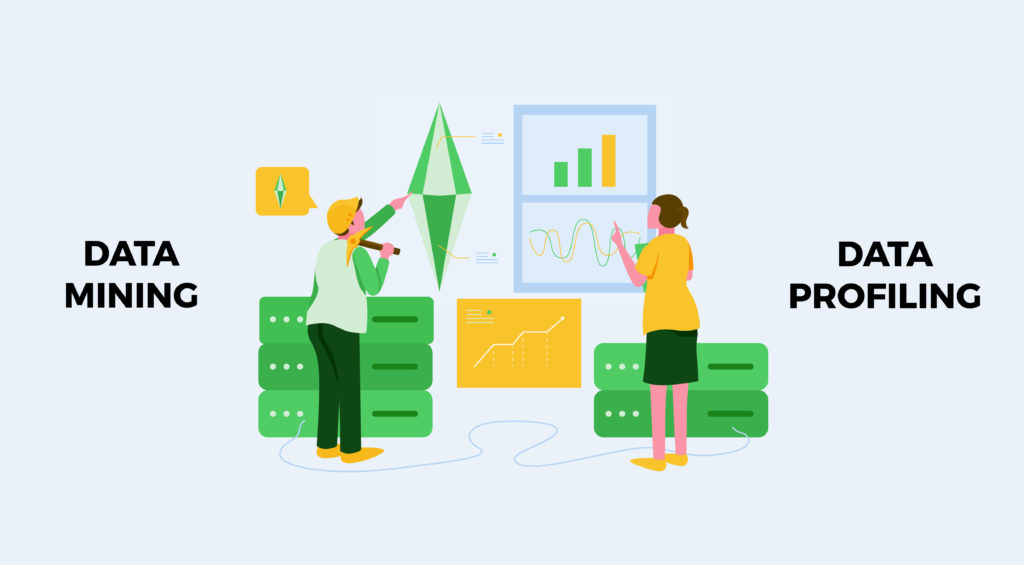While working in the field of machine learning and data analytics, data profiling and data mining are used quite extensively with various definitions scattered across. The two terms are often confused, and people even use it interchangeably in some cases. While both may seem to be the same thing, they are not. Firstly, data mining has been in use for quite some time, whereas data profiling is a relatively rare and new topic.
With this article, we try to analyse the differences between these two topics in terms of concepts, applications and more. Here we begin.
Understanding The Two Terms
Data Mining
Data mining refers to the process of identifying patterns in a pre-built database. It carries out analysis or knowledge discovery in the databases to evaluate the existing database and large datasets to turn raw data into useful information and find trends and patterns into it.
To simply put, it collects the patterns and knowledge from the available data, identifying the valid, novel and potentially useful data and trends in data to solve problems through data analysis in otherwise scattered data.
Once the correlations within the large datasets are identified, this knowledge is fed into areas such as business intelligence and analytics to understand the large, complex datasets in various industries. It identifies the hidden patterns, searches for new, valuable and non-trivial knowledge to generate useful information.
It involves a full statistical and algorithmic analysis of a typical extensive data set and querying a database for various parameters. For instance, it can carry sentiment analysis to know how people felt about a particular product or service. Some of the standard data mining tools are RapidMiner, Apache SAMOA.
Data Profiling
Data Profiling, on the other hand, also analyses raw data from existing datasets, but to collect statistics or informative summaries about the data. Also called data archaeology, data profiling is used to derive information about the data itself and assess the quality of the data. It also helps evaluate data sets for consistency, uniqueness and logic while preparing it for subsequent cleansing, integration, and analysis.
It primarily deals with the data quality, in areas such as enterprise data warehousing, to identify anomalies in datasets. It identifies the wrong data at the initial stage of data so that it can be corrected at the right time.
Some of the ways in which data profiling can be conducted are mean, minimum, maximum, percentile, frequency, aggregates and more. Profiling tools evaluate the actual content, structure and quality of the data by exploring relationships that exist between value collections both within and across data sets. Some of the standard data profiling tools are Talend Open Studio, Aggregate Profiler, and more.
In a nutshell, data mining mines actionable information while making use of sophisticated mathematical algorithms, whereas data profiling derives information about data quality to discover anomalies in the dataset.
Data Mining And Data Profiling Techniques
Data Mining
Some of the common techniques of data mining are association learning, clustering, classification, prediction, sequential patterns, regression and more.
- Association learning is the most commonly used technique where relationships between items are used to identify patterns. It is also called relation technique.
- Classification technique classifies items or variables in a data set into predefined groups or classes. It uses linear programming, statistics, decision trees, and artificial neural networks in data mining.
- Clustering technique creates meaningful object clusters that share the same characteristics. Unlike classification that puts objects into predefined classes, clustering puts objects in classes that are defined by it.
- Prediction technique predicts the relationship that exists between independent and dependent variables as well as independent variables alone.
- Sequential patterns technique is used to identify similar trends, patterns, and events in it over a period of time.
Data Profiling
The different kinds of data profiling are:
- Structure discovery or structure analysis that makes sure that the data is consistent and formatted correctly. It examines simple basic statistics in data.
- Content discovery, on the other hand, looks more closely into the individual elements of the database. It helps in identifying null values or values that are incorrect or ambiguous.
- Relationship discovery analyses the type of data used to gain a better understanding of the connections between the data sets. Starting with metadata analysis, it narrows down to identifying data overlaps.
Wrapping Up
After a brief analysis of the two concepts, it can be said that some of the techniques of data mining are used for data profiling. Data mining is a rather broad concept which is based on the fact that there’s a need to analyse massive volumes of data in almost every domain and data profiling adds value to that analysis. Many steps, such as data cleaning and data preparation, are similar in both the concepts, and it is the handling of data for an ultimate different goal that makes these two different.





















